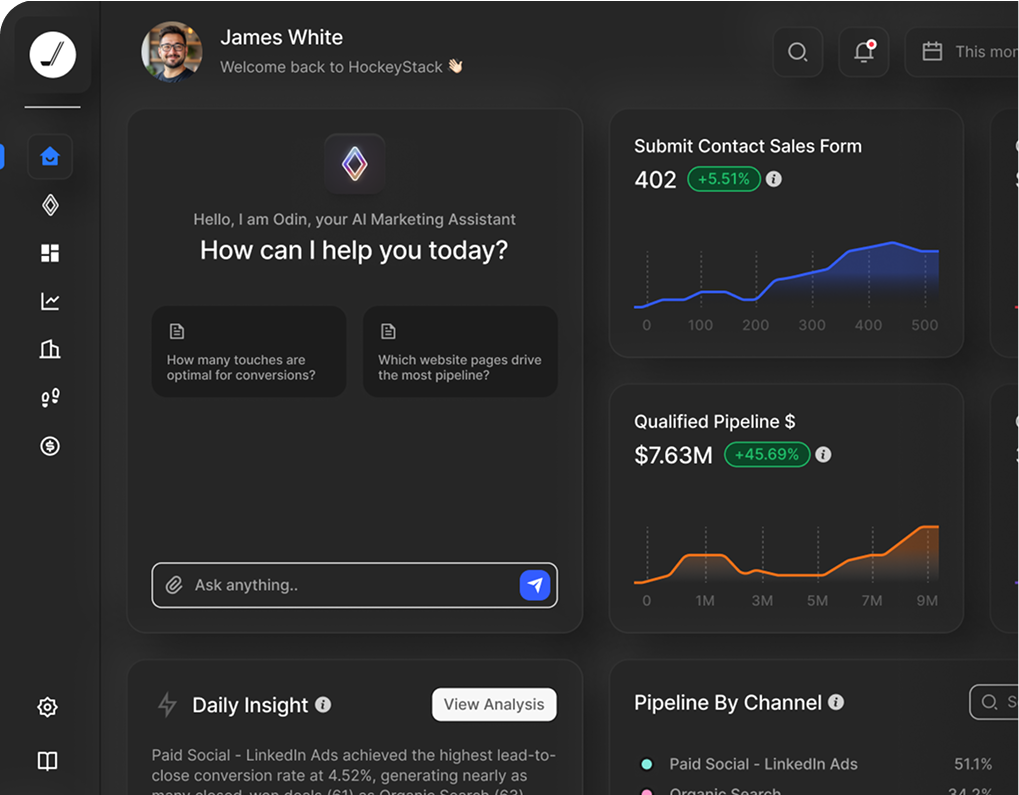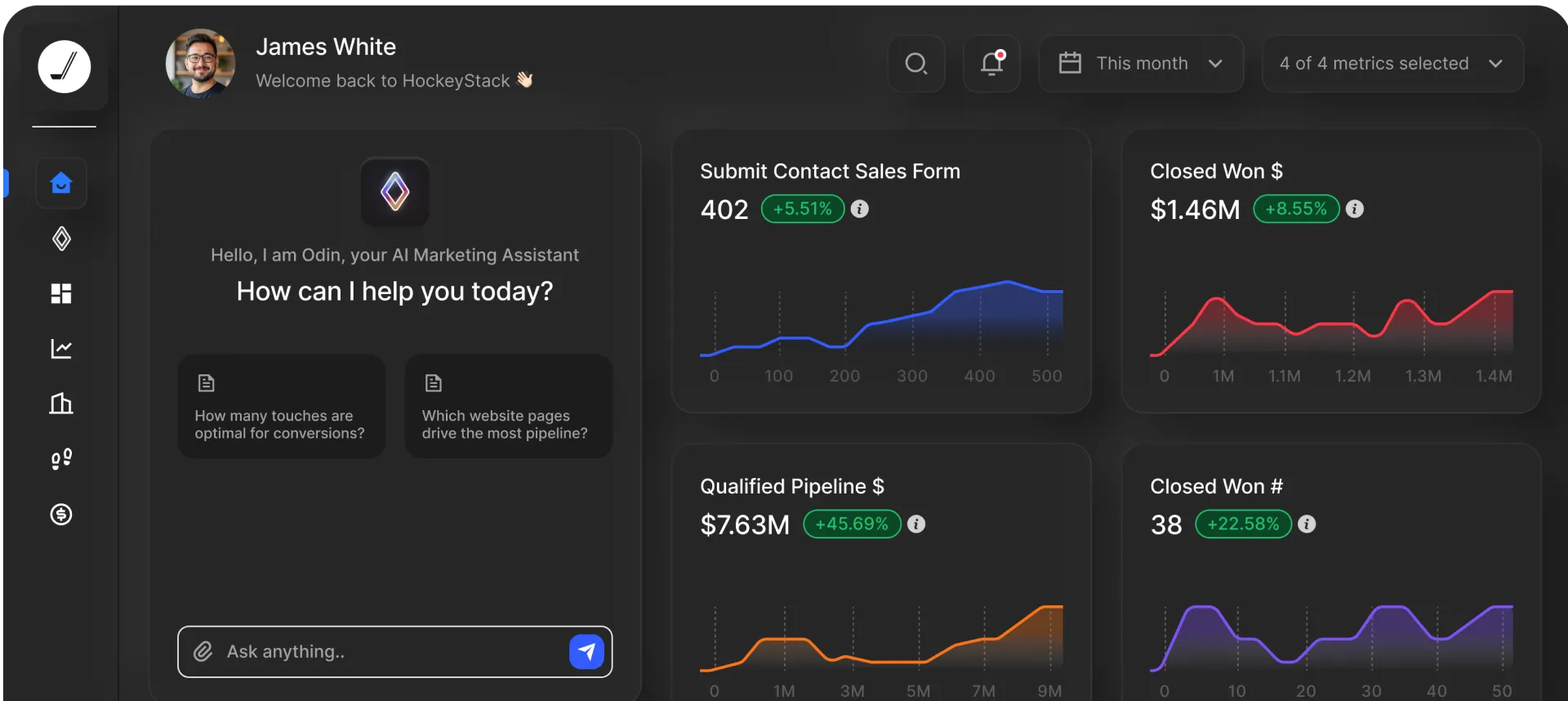B2B Marketing Analytics 101: For Marketers Who Don’t Have Time to Be Data Scientists

B2B Marketing Analytics 101: For Marketers Who Don’t Have Time to Be Data Scientists

B2B marketing has never been more measurable or more confusing. We track everything and understand nothing.
Your data is scattered across Google Analytics, Salesforce, LinkedIn Ads, HubSpot, and five other platforms you forgot you're paying for. Meanwhile, connecting touchpoints to actual revenue feels nearly impossible.
You're left with the same questions every month:
- Which marketing campaigns drive revenue?
- Where are leads falling through the cracks?
- Are you doubling down on what works or just wasting time with fancy dashboards?
B2B marketing analytics clears up this confusion. It connects every touchpoint from awareness to closed-won deals, so you can see exactly which campaigns bring revenue and which ones are burning cash.
We’ll show you how to build this system and walk you through everything, from setting up proper tracking to creating dashboards that your CEO actually understands.
How Would You Define B2B Marketing Analytics?
Ask ten B2B marketers to define marketing analytics, and you'll get eleven different answers.
Here's how we define it at HockeyStack:
B2B marketing analytics means measuring, tracking, and analyzing marketing performance to understand which activities drive qualified leads and revenue.
The core purpose of B2B marketing analytics is to help marketing, sales, and RevOps teams make faster, informed decisions about where to invest, which marketing strategies work best, and how to generate more pipeline from high-value accounts.
B2B marketing analytics is different compared to B2C because your customers don't impulse-buy a $50,000 software license after seeing a single Facebook ad.
B2B handles longer sales cycles, multiple stakeholders, and higher-value transactions that B2C simply doesn't deal with.
What makes this even harder today is that buyers leave fewer signals. They talk to peers in Slack groups, consume content anonymously, and don’t fill out forms. A strong analytics setup is the only way to connect the dots between marketing and revenue.
How to Get Started With B2B Marketing Analytics (Main Components)
Setting up B2B marketing analytics doesn't have to be overwhelming. We can break it down into these core components and tackle them one at a time:
Define Clear Goals and KPIs
Start with your revenue goals and work backwards. If you need to generate $5M in new business this year, ask yourself:
- How many qualified leads does that require?
- What's your average deal size?
- What's your conversion rate from marketing qualified leads to closed-won?
And instead of "increase website traffic by 30%," set business goals like "generate 150 enterprise MQLs with an average deal size of $75K." This forces you to think about the quality and value of leads.
Your KPIs should ladder up from daily activities to quarterly revenue targets. For example:
Daily content engagement → weekly lead generation → monthly MQL targets → quarterly pipeline goals → annual revenue.
Each level should have clear benchmarks that sales and leadership can understand.
Set Up Tracking and Data Collection
Your CRM should be the foundation. Whether that's Salesforce, HubSpot, or Pipedrive, this is where all your leads and deals exist, and everything else connects back to this system.
For website tracking, Google Analytics 4 handles the basics, but you'll probably need something more robust for granular user behavior analysis. Google Tag Manager is the usual go-to for setting up UTMs.
And if you're serious about multi-touch attribution, platforms like HockeyStack can help you centralize web activity, CRM actions, call data, and even third-party intent—all in one place.
It won’t be perfect on day one, and that’s fine. The goal is to set up clean, consistent tracking and avoid collecting data you don’t plan to use.
PRO TIP: Set up consistent naming rules for campaigns from day one, or you'll spend months later trying to figure out what "Q2Campaign_Final_v3" actually was.
Integrate Data Sources
Even the best data is useless if it’s stuck in silos. To get a full picture of your buyer journey, you need to connect your key platforms, including your CRM analytics, marketing automation, website analytics, ad platforms, and any intent tools.
Common integrations include:
- HubSpot or Marketo → Salesforce to sync lead lifecycle stages, campaign activity, and scoring data
- Google Analytics → attribution tools like HockeyStack to connect traffic sources to pipeline and revenue
- LinkedIn Ads / Google Ads → CRM to track which ad campaigns get qualified leads and closed-won deals
- Website and product analytics → Segment or a CDP to centralize user behavior across marketing, sales, and product touchpoints
- Intent platforms → Slack or CRM objects to alert reps when key accounts show in-market behavior, competitor research, or surge activity
Unified data is what makes cross-channel reporting and attribution actually work.
PRO TIP: HockeyStack eliminates the data integration nightmare because it automatically connects your entire GTM tech stack—CRM, marketing automation, ad platforms, and website analytics—into one unified view. You get complete buyer journey insights and cross-platform attribution in a single dashboard.
Analyze and Derive Insights
Ask the questions that matter to your business:
- Which channels bring in your highest-value customers?
- What content pushes deals forward at each stage?
- How long do prospects take to move from awareness to purchase?
Your analytics should answer these specific questions, not just show you pretty charts. Then, look for patterns in your best-performing campaigns and customer journeys.
Maybe your enterprise customers always read case studies before they book demos. Or, your hottest leads discover you on LinkedIn but convert through email nurturing. These insights become your playbook for scaling what works.
When you can prove that LinkedIn ads cost $2,000 per customer but generate $50K in lifetime value, while Google Ads cost $500 but only bring in $5K customers, budget decisions become obvious.
Choose Your Attribution Model
The right attribution model depends on how long your sales cycle is, how many stakeholders are involved, and how buyers typically move through your sales funnel.
Early-stage startups with shorter cycles might get value from simple first- or last-touch models. But if you’re running multi-channel campaigns across months, you’ll need something more advanced, such as W-shaped, time decay, or even algorithmic models.
Here's your quick rundown of the main models:
- First-touch attribution gives all credit to the first interaction (great for understanding awareness drivers)
- Last-touch attribution credits only the final touchpoint before conversion (useful for closing tactics)
- Linear attribution splits credit equally across all touchpoints (fair but not very insightful)
- Time-decay attribution gives more weight to recent interactions (shows that recent touches might matter more)
- Position-based (U-shaped) prioritizes first and last touches, with some credit to middle interactions
- Data-driven attribution uses machine learning to assign credit based on actual conversion patterns
The best approach is to run multiple models simultaneously for 90 days and compare how different attribution models change your channel performance rankings.
PRO TIP: HockeyStack combines multi-touch attribution with self-reported attribution to show you the complete story, not just one piece of it. You can track performance across the entire funnel at the channel, campaign group, campaign, and ad levels, which gives you the granular insights you need to optimize budget plans.

Build Dashboards and Reports
So many marketing dashboards fail because they try to be everything to everyone. Your CMO doesn't need to see email open rates, and your demand gen manager doesn't need board-level summaries.
The best tip is to build different views for different audiences.
- Your executive summary should fit on one screen with revenue attribution, CPA, and pipeline velocity.
- Your campaign performance view needs channel-level breakdowns with conversion rates and ROI by source.
- Your operational dashboard tracks the messy details like form conversion rates, email deliverability, webinar signups, and lead scoring accuracy.
Update frequency matters too. For example, you can track real-time data for paid ads, weekly for campaign performance, and monthly for strategic decisions.
PRO TIP: HockeyStack's no-code dashboard builder lets anyone create custom reports without waiting on data teams or engineering resources. You can build role-specific dashboards using their drag-and-drop interface.
Benefits of B2B Marketing Analytics
Here's what actually happens when you get your digital marketing analytics working properly:
- Finally stop throwing money at campaigns that don't work: You'll know which channels are burning through budget without bringing in decent leads, so you can kill them and spend that money somewhere useful.
- Get deals moving faster through your pipeline: Figure out exactly which marketing efforts make prospects convert quicker, then repeat that playbook.
- End the eternal sales vs. marketing lead quality arguments: You can track which campaigns generate leads that turn into paying customers to get both teams on the same page.
- More accurate forecasting: If your data shows how buyers are actually behaving (not just what’s in the CRM), you’ll get more realistic pipeline projections.
- Shorten long sales cycles: Spot which marketing moves get prospects to sign faster, then systematically scale these tactics.
- Faster campaign optimization: Instead of waiting until end-of-quarter reports, you can spot trends and adjust campaigns in real time.
- Know what you're paying for customers: Understand the true cost to land customers from different channels.
- Better lead prioritization: Not all leads are equal, and analytics helps you sort the ones that are just curious from the ones ready to buy.
- Stronger retention and expansion plays: You can intervene before a renewal is at risk or open a conversation when a customer shows signs of expansion interest.
What Metrics to Measure in B2B Marketing
Now that you understand the framework, let's talk about what you should actually be measuring. Here’s what you should pay attention to:
Engagement & Behavior Metrics
These metrics show you how prospects actually interact with your content and website before they become leads. While they won't directly tell you about revenue, they show which content resonates, where people drop off, and what keeps them engaged long enough to convert.
Here are some of the most useful engagement metrics:
- Page views and time on page: See which pages your buyers are spending the most time on, especially high-intent ones like pricing, integrations, or use case breakdowns.
- Scroll depth and click-through rates: Measuring how far someone scrolls and whether they click into other content helps you filter passive traffic from real account engagement.
- Form conversion rates: Track how well your landing pages, gated content, or demo forms are converting. If traffic is high but conversions are low, it’s usually a messaging or UX issue.
- Content engagement by funnel stage: Knowing which top, mid, and bottom-funnel assets are getting consumed helps you prioritize what to create (or fix) next.
- Return visits and session frequency: If someone keeps coming back, especially to product-related content, they’re likely moving down the funnel.
Revenue & Pipeline Metrics
This is where marketing either gets budget or gets questioned. If you can’t show how your efforts impact pipeline or revenue, it’s hard to make a case for more spend or headcount.
Here are the revenue metrics every B2B marketer should track:
- Pipeline sourced by campaign or channel: Shows which campaigns actually generate new opportunities (not just hand-raisers).
- Pipeline influenced: Track how marketing touchpoints contribute to deals already in motion, especially in long sales cycles with multiple contacts involved.
- SQL to Opportunity conversion rate: Helps you assess the quality of marketing-qualified leads and whether they’re truly sales-ready.
- Revenue by channel or content type: Tells you which channels close deals. Use this to justify investments and optimize your mix.
- Average deal size and sales cycle length: If deals sourced from marketing close faster or for more revenue, that’s a strong argument for doubling down on what’s working.
Lead Generation & Conversion Metrics
These metrics help you figure out which campaigns are bringing quality leads and whether you’re moving them through the funnel successfully.
Here are the lead generation metrics you should pay attention to:
- MQL volume and source breakdown: Track how many marketing-qualified leads you’re generating and where they’re coming from (organic, paid, referral, etc.), so you know where to scale.
- MQL to SQL conversion rate: Shows how many of your “qualified” leads actually get accepted by sales. If this number is low, your scoring or handoff process probably needs work.
- Landing page conversion rates: See which offers or pages are converting best. High traffic with low conversion usually means weak messaging or the wrong audience.
- Lead-to-opportunity rate: This gives you a read on how well your top-of-funnel activity is translating into actual sales conversations, not just names in a database.
Sales Cycle Analytics
Sales cycle analytics show you how long it actually takes to close a deal and where that process breaks down. Here are the sales cycle metrics that companies should keep an eye on:
- Average sales cycle length: Measures the time from first marketing touch to closed-won. Break it down by source, persona, or deal type to spot which paths are faster or dragging.
- Stage duration by opportunity: Shows how long deals spend in each pipeline stage. Useful for spotting where reps need support, content, or better qualification.
- Time to first follow-up: Tracks how quickly sales engages after a lead hits “qualified” status. Delayed follow-up is one of the most common deal-killers.
- Touchpoints per deal: Reveals how much effort it takes to close. If high-value deals always require 15+ touches, make sure your outreach and nurture programs support that.
- Stalled or aging opportunities: Flags deals that haven’t moved in a set number of days, so reps can re-engage or disqualify instead of letting them rot in the CRM.
Best Practices for Effective B2B Marketing Analytics
Even with perfect tracking and the right metrics, your analytics can still fail if you don't follow some basic principles.
These practices make the difference between useful insights and useless reports:
- Align analytics with sales outcomes, not just marketing activity: Track metrics that tie directly to revenue, like pipeline sourced, influenced revenue, and opportunity conversion rates. If your dashboards stop at MQLs or website traffic, you’re not showing the full picture of marketing’s impact.
- Customize dashboards for different stakeholders: A CMO needs different insights than a demand gen manager or RevOps lead. Build role-specific dashboards so each team sees only the data that matters to their data-driven decisions.
- Use reverse attribution to validate your models: Start with closed-won deals and work backwards to see which touchpoints actually influenced those conversions. This often shows that your attribution model is giving credit to the wrong channels, especially for complex B2B sales cycles.
- Use statistical significance testing for campaign decisions: Don't make budget decisions based on small sample sizes or short time periods. Run campaigns long enough to gather statistically significant data, especially for low-volume B2B channels.
- Track conversion rates between every stage of the funnel: Track every handoff (MQL → SQL, SQL → Opp, Opp → Win) to diagnose exactly where deals are getting stuck or leads are falling off.
- Automate alerts and reporting where possible: Set up Slack or email engagement alerts when high-intent accounts surge, deals stall, or conversion rates drop. Real-time data helps your team respond faster and avoid waiting for the next dashboard review.
- Create separate funnels for different buyer personas - Enterprise prospects behave differently than SMB buyers, so track their journeys separately. Your enterprise leads might take 6 months to convert while SMB leads close in 30 days.
- Regularly audit your tracking and attribution setup: UTMs break, forms get updated, workflows change, so don’t assume your data is clean just because the dashboard loads. Set a monthly or quarterly cadence to check key tracking points and attribution logic.
Common B2B Marketing Analytics Challenges
Every company faces similar analytics challenges, regardless of size or industry. Knowing what's coming helps you prepare for these common obstacles:
- Data silos and disconnected platforms make attribution impossible: Your marketing automation, CRM, and ad platforms don't integrate, so you’re left manually stitching together incomplete data.
- Long sales cycles break traditional attribution models: When prospects take 6-12 months to convert and touch 15 different marketing channels, you spend weeks figuring out which touchpoints actually matter.
- Offline marketing activities are nearly impossible to track: Trade shows, direct mail, sales outreach, and word-of-mouth referrals bring leads that your analytics platforms never see. You end up with huge gaps in attribution that make your digital channels look artificially important compared to offline efforts.
- Sales teams enter data inconsistently or not at all: Half your opportunities are missing lead sources, deal stages get skipped, and close dates constantly change without explanation. When sales data is subpar, your marketing attribution becomes subpar too, no matter how sophisticated your tracking setup.
- Multiple decision makers complicate individual-based tracking: B2B buying committees involve 5-10 people at each company, but most analytics tools only track individual contacts, not account-level interactions.
- Privacy regulations and cookie deprecation limit tracking accuracy - iOS updates, GDPR compliance, and third-party cookie elimination mean you're losing insight into prospect behavior. What used to be trackable customer journeys now show up as unknown sources in your analytics.
Top Tools and Platforms for B2B Marketing Analytics
No single platform solves every B2B marketing analytics challenge, so most teams end up with a stack of 3-5 tools. Understanding what each type of platform does best helps you build the right combination:
Web Analytics Tools
You need web analytics platforms to track how prospects behave on your website, which pages drive conversions, and where your traffic actually comes from.
Popular choices:
- Google Analytics 4 dominates because it's free and handles complex B2B tracking through custom events and conversion goals
- Microsoft Clarity provides heatmaps and session recordings that show exactly how prospects interact with your landing pages and forms
Customer Relationship Management (CRM) Systems
Your CRM is the central hub where all prospect and customer data exists. Marketing and sales teams use it to track lifecycle stages, log interactions, and coordinate outreach based on real-time activity.
The best B2B CRMs integrate directly with marketing platforms to provide seamless attribution from first touch to revenue.
Popular choices:
- Salesforce with Pardot provides enterprise-grade marketing automation and robust attribution reporting for complex B2B sales cycles
- HubSpot CRM is an all-in-one solution that's easier to implement with built-in marketing automation, and it’s popular among growing B2B companies
Marketing Automation Platforms
Marketing automation platforms are the central system for your lead nurturing and campaign execution. They show you how prospects interact with your emails, download your content, and browse your website, then score those leads based on their behavior.
Popular choices:
- Marketo excels at complex lead scoring and enterprise-level automation workflows
- HubSpot Marketing Hub combines ease of use with powerful automation functionality and seamless CRM integration
Social Media Analytics Tools
Social media analytics tools measure how your content performs, what drives clicks or conversions, and which channels actually move the needle apart from likes and follows.
Popular choices:
- LinkedIn Campaign Manager is the go-to for B2B ad insights and lead gen form tracking.
- Hootsuite and Sprout Social offer centralized dashboards for scheduling, monitoring, and performance reporting across platforms.
- Native platform insights offer basic performance tracking from LinkedIn, Twitter, and Facebook
Business Intelligence & Data Visualization Tools
These tools connect to multiple data sources and let you centralize all that data with dashboards and reports where you can spot specific trends and patterns.
Popular choices:
- Looker Studio (formerly Google Data Studio) is free and integrates well with Google's ecosystem for basic reporting needs
- Tableau has advanced visualization capabilities for complex B2B analytics
- Power BI provides enterprise-grade reporting with strong Microsoft integration
Attribution & Specialized B2B Analytics Tools
These platforms are built specifically for B2B marketing attribution and multi-touch journey analysis. They connect marketing touchpoints to revenue across long sales cycles and multiple decision makers.
Popular choices:
- HockeyStack is a comprehensive AI GTM platform that unifies data from all your marketing channels, CRM, and sales tools in one dashboard. It tracks revenue influence, maps entire buyer journeys, and builds reports that actually make sense to non-technical marketing teams (and that’s just the tip of the iceberg).
- Dreamdata specializes in multi-touch attribution and streamlines pipeline visibility across GTM teams.
- Bizible (now Adobe Marketo Measure) provides enterprise-level attribution modeling for large organizations with complex sales processes
Making the Most Out of Your B2B Marketing Data with HockeyStack
HockeyStack is the AI-powered analytics platform that unifies all your GTM data into a single source of truth, with two specialized AI agents (Odin and Nova) that automate workflows and solve data fragmentation issues.
While most teams spend hours manually combining data from different platforms, HockeyStack connects your entire tech stack automatically to show complete attribution across every touchpoint.
Here's precisely what HockeyStack brings to the table:
- Get instant answers with Odin, your AI marketing analyst: Ask Odin to analyze performance, build custom reports from text prompts, outline which campaigns to cut, or prepare board meeting summaries, all in just a few minutes.
- Automate account research and sales workflows with Nova: Nova outlines high-intent accounts using buyer journey data, runs automated account research, and creates personalized account plans with stakeholder mapping and role-specific messaging recommendations.
- Unify attribution across your entire tech stack: You can compare multiple attribution models side by side in any report to understand which marketing and outbound activities actually drive revenue.
- Build AI-powered workflows that run automatically: Detect buying signals like key accounts visiting your demo page, automatically qualify them based on ICP criteria, pull relevant contacts, and route them to appropriate sequences (all in real-time without manual intervention).
- Identify and de-anonymize website visitors at the account and contact level: See not just which companies visit your website, but which specific individuals from target accounts are on which pages, with real-time Slack notifications when high-value prospects are actively browsing.
- Run lift analysis to measure incremental campaign impact: Answer questions like "would you lose sales if you paused branded search campaigns?" with lift reports that show the true incremental impact of each marketing activity.
- Scale account intelligence with intent data and custom scoring: You can combine first-party engagement activity data with third-party intent signals from partners to identify accounts actively researching your category, with custom scoring models that explain exactly why each account is prioritized.
When you're tired of cobbling together marketing reports from six different platforms and trying to prove ROI with incomplete data, HockeyStack gives you the complete attribution picture that B2B marketing needs.
Book a demo and see how HockeyStack can eliminate your data fragmentation headaches.
FAQs
Do I need a dedicated data scientist to get started with B2B analytics?
Not anymore. Modern B2B analytics platforms like HockeyStack are built for marketing managers and teams, not data scientists. You can ask questions in plain English and get instant reports without writing SQL.
Tools like Odin, HockeyStack's AI analyst, automatically analyze your data and provide actionable recommendations.
How do you track return on investment (ROI) when the B2B sales cycle is so long?
Focus on metrics like pipeline influence, deal velocity, and conversion rates by channel and campaign. Attribution modeling also helps connect early-stage touchpoints (like content or ads) to revenue later down the line, even if it takes months to close.
Our data is a mess and lives in different tools. Where should we even begin?
Start with your CRM as the foundation and make sure lead sources and deal stages are consistently tracked there first. Then connect your most important marketing platform (usually email automation or ads) to see basic attribution.
Don't try to integrate everything at once, just pick 2-3 core tools and connect them first. Clean, consistent data from a few sources beats messy data from everywhere.
11 Best AI Reporting Tools & Solutions for 2025 (Based on User Reviews)
Looking for an AI reporting solution that won't disappoint? These 11 tools are what data professionals are actually recommending in 2025.


Ready to see HockeyStack in action?
HockeyStack turns all of your online and offline GTM data into visual buyer journeys and dashboards, AI-powered recommendations, and the industry’s best-performing account and lead scoring.

Ready to See HockeyStack in Action?
HockeyStack turns all of your online and offline GTM data into visual buyer journeys and dashboards, AI-powered recommendations, and the industry’s best-performing account and lead scoring.




